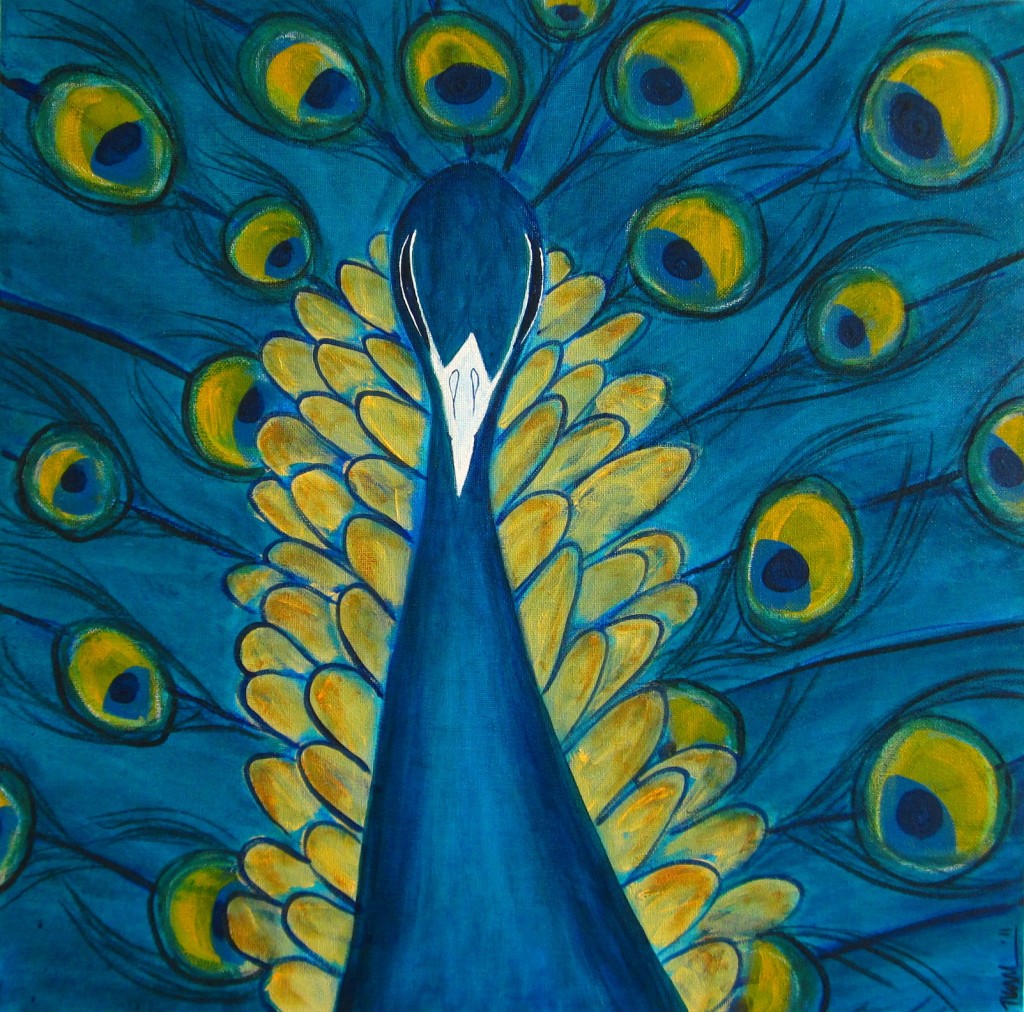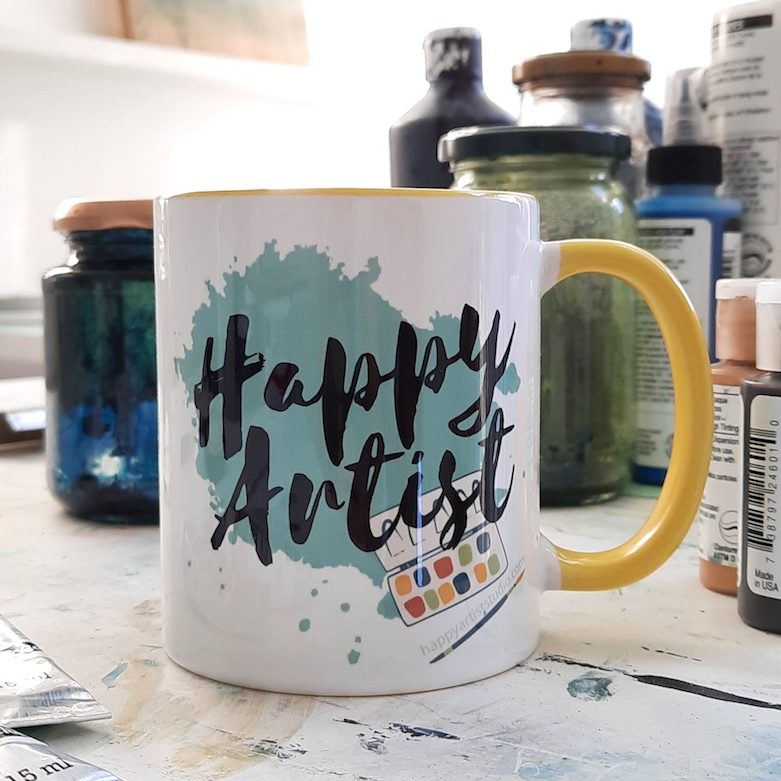I want to say upfront that I am not the guru of how to know when a painting is finished. Hell no. As much as I hope that this post will be useful and/or interesting to you, it’s an exploration for me too. There is a special corner of my studio {ok, two} reserved specifically for The Unfinished Ones, and it hasn’t diminished recently.
I’ve included some of my paintings to illustrate different ways that a painting can tell you it’s finished.

Angels are Everywhere.
Sometimes paintings don’t need much before they’re finished. In fact, part of their finishedness is in looking kind of unfinished.
I watched the documentary ‘Gerhard Richter Painting’ recently. I found a lot of it kind of dry, but watching him paint was pretty interesting. After the first layer he leaves the paintings for an hour, a day, or longer before knowing if they’re finished or what more they need. You can see him in the film contemplating the paintings.
His assistants joke {at least I think they were joking ~ they were deadpan throughout so it was hard to tell and I don’t speak German so I didn’t always understand the nuances} that they can never be sure if a painting is finished; Richter may come back and do more, he may not. They have to wait and see.
But the thing that struck me was when one of the assistants said, “After a while you just know“. This is exactly my process, only I hadn’t really articulated it or accepted it as a possible means of discovering whether a painting is finished. Of course someone else describing your method is always a great validation. 🙂
Here’s one that exactly illustrates that phrase:

What Was Invisible Begins To Be Revealed.
For ages I thought it wasn’t finished, and then suddenly I realised it was.
Carrie Schmitt, who paints beautiful flowers, carries her paintings around the house with her while she ponders what they may or may not need to be complete. I know of several artists who keep adding things until something just clicks inside them, and they feel it is finished.
Creating being such an emotional, right brain, intuitive visceral process, this makes total sense to me. Until you’re standing in front of a piece not getting any vibes. For some it’s a more practical case of ‘there’s nothing more I can add here’.

Grace.
One of the many joys of mixed media painting is that you can just add stuff and cover it over til you’re happy.
In the painting above the mixed media-ness of the painting means potentially you could go on adding things forever. I think this can be true of abstract work too. I find that just telling people a painting is finished is often like drawing a line under it.
Even if I wasn’t really sure myself, no one has ever questioned me on it, and just the act of saying it’s complete is enough for it to become true.

Move.
This is a good example of a painting that pretty much painted itself and knew exactly when it was finished. I do kind of wish they were all like that but would we learn without being pushed by challenges?
It can be quite easy to get caught up in judgement about how long you’ve spent on a painting, or how easily it came together. I don’t know about you but I can get in a pickle if I start going down the road of ‘too quick and too easy means it’s not a good/finished/valid painting’. Nonsense of course.
The painting above, one of my favourites ever, was the perfect dance of spirit, brush, paint and canvas that we all dream of. It didn’t take weeks, I didn’t agonise over it, I was simply the vessel for it to come through, inspired by a Nia class. Sometimes it really is that simple.

Peacock.
One good way to know when a painting is finished is to make it OF something. Then when you’ve finished painting whatever the object is, it’s done. Boom.
I don’t often paint ‘things’, as in recognizable single subjects. This peacock came about pretty quickly though, and I knew it was done because all the elements were there and there was nothing more to do! Sometimes it’s that simple too.
One of the joys of art for me is that it’s not like maths; there’s no right or wrong, or final answer. There are probably as many different ways to know if paintings are finished as there are artists to paint them.

Holding Space.
A work in progress that sat for MONTHS unfinished and too confusing for me to even look at. Then one day, it turned into the painting on the right. Which I really love.
If you Google the topic, there are plenty of opinions out there. In fact the sheer number of words written about it shows just how much it is an issue for many artists.
If I were to to break it down, I’d say the following are some good ways that I’ve found useful to get to the point where you ‘just know’:
~ Turn the painting upside down or hold it up to a mirror. That’ll show you pretty quickly where any imbalances are.
~ Hang it in the living room so you see it every day in passing, or can contemplate it from time to time.
~ Have a conversation with it. Seriously. Ask it what it needs, what’s missing. Sometimes I feel a painting looks done but doesn’t feel like it’s saying anything. It feels a bit flat. If it wants to say something, how will you know if you don’t ask? It’s just a conversation with yourself, really.
~ If it feels unfinished but you don’t know what it needs, consider the possibility that it is actually finished. As a friend of mine says, ‘stop when it looks interesting’. And remember to leave a bit of space for the viewer’s imagination.
~ Does the eye travel easily over and around the painting? Are any areas jarring, or less comfortable to look at? Do they need integrating?
~ Be patient. My least favourite, but probably the most effective. Time will always bring things to fruition, which isn’t the same as saying you’ll always finish every painting. Some paintings don’t come full circle and that’s ok.
Do you paint? How do YOU gauge when a painting is finished? I’m always interested in new approaches so please share your wisdom!








Tara, these paintings and your words are WONDERFUL!! i love how you go into the process of KNOWING when a painting is done. Your work is absolutely captivating. i love your colors the most, and the way you blend one into the other. Feels very free to me… beautiful work. xox
Thanks P! You saved me from the fear of having written something boring/obvious. ;)x
oh Tara I LOVE that painting above on the right, fabulous truly! Good ideas in this blog, thank you!
Thank you Dona! So glad you enjoyed it.
Great post Tara – love how you’ve illustrated with your work. Beautiful!